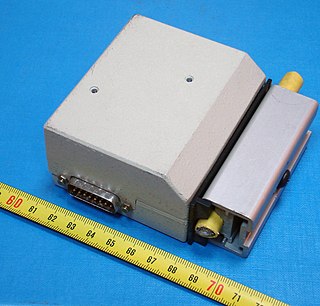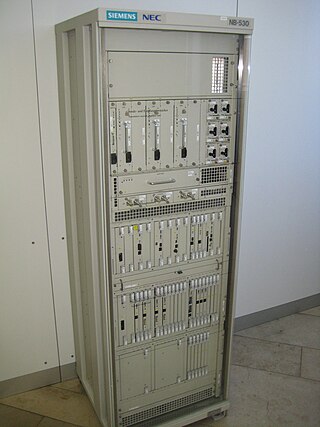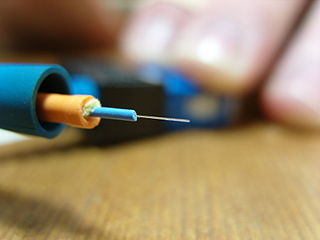Related Research Articles

A wireless network is a computer network that uses wireless data connections between network nodes. Wireless networking allows homes, telecommunications networks and business installations to avoid the costly process of introducing cables into a building, or as a connection between various equipment locations. Admin telecommunications networks are generally implemented and administered using radio communication. This implementation takes place at the physical level (layer) of the OSI model network structure.

10BASE2 is a variant of Ethernet that uses thin coaxial cable terminated with BNC connectors to build a local area network.

10BASE5 was the first commercially available variant of Ethernet. The technology was standardized in 1982 as IEEE 802.3. 10BASE5 uses a thick and stiff coaxial cable up to 500 meters (1,600 ft) in length. Up to 100 stations can be connected to the cable using vampire taps and share a single collision domain with 10 Mbit/s of bandwidth shared among them. The system is difficult to install and maintain.

In computer networking, Fast Ethernet physical layers carry traffic at the nominal rate of 100 Mbit/s. The prior Ethernet speed was 10 Mbit/s. Of the Fast Ethernet physical layers, 100BASE-TX is by far the most common.
In the seven-layer OSI model of computer networking, the physical layer or layer 1 is the first and lowest layer: the layer most closely associated with the physical connection between devices. The physical layer provides an electrical, mechanical, and procedural interface to the transmission medium. The shapes and properties of the electrical connectors, the frequencies to transmit on, the line code to use and similar low-level parameters, are specified by the physical layer.
10BROAD36 is an obsolete computer network standard in the Ethernet family. It was developed during the 1980s and specified in IEEE 802.3b-1985. The Institute of Electrical and Electronics Engineers standards committee IEEE 802 published the standard that was ratified in 1985 as an additional section 11 to the base Ethernet standard. It was also issued as ISO/IEC 8802-3 in 1989.

The base station subsystem (BSS) is the section of a traditional cellular telephone network which is responsible for handling traffic and signaling between a mobile phone and the network switching subsystem. The BSS carries out transcoding of speech channels, allocation of radio channels to mobile phones, paging, transmission and reception over the air interface and many other tasks related to the radio network.
A base transceiver station (BTS) or a baseband unit (BBU) is a piece of equipment that facilitates wireless communication between user equipment (UE) and a network. UEs are devices like mobile phones (handsets), WLL phones, computers with wireless Internet connectivity, or antennas mounted on buildings or telecommunication towers. The network can be that of any of the wireless communication technologies like GSM, CDMA, wireless local loop, Wi-Fi, WiMAX or other wide area network (WAN) technology.

Small Form-factor Pluggable (SFP) is a compact, hot-pluggable network interface module format used for both telecommunication and data communications applications. An SFP interface on networking hardware is a modular slot for a media-specific transceiver, such as for a fiber-optic cable or a copper cable. The advantage of using SFPs compared to fixed interfaces is that individual ports can be equipped with different types of transceivers as required, with the majority including optical line terminals, network cards, switches and routers.
RS-485, also known as TIA-485(-A) or EIA-485, is a standard, originally introduced in 1983, defining the electrical characteristics of drivers and receivers for use in serial communications systems. Electrical signaling is balanced, and multipoint systems are supported. The standard is jointly published by the Telecommunications Industry Association and Electronic Industries Alliance (TIA/EIA). Digital communications networks implementing the standard can be used effectively over long distances and in electrically noisy environments. Multiple receivers may be connected to such a network in a linear, multidrop bus. These characteristics make RS-485 useful in industrial control systems and similar applications.

A Medium Attachment Unit (MAU) is a transceiver which converts signals on an Ethernet cable to and from Attachment Unit Interface (AUI) signals.

Multi-mode optical fiber is a type of optical fiber mostly used for communication over short distances, such as within a building or on a campus. Multi-mode links can be used for data rates up to 800 Gbit/s. Multi-mode fiber has a fairly large core diameter that enables multiple light modes to be propagated and limits the maximum length of a transmission link because of modal dispersion. The standard G.651.1 defines the most widely used forms of multi-mode optical fiber.

The Open Base Station Architecture Initiative (OBSAI) was a trade association created by Hyundai, LG Electronics, Nokia, Samsung and ZTE in September 2002 with the aim of creating an open market for cellular network base stations. The hope was that an open market would reduce the development effort and costs traditionally associated with creating base station products.
Radio over fiber (RoF) or RF over fiber (RFoF) refers to a technology whereby light is modulated by a radio frequency signal and transmitted over an optical fiber link. Main technical advantages of using fiber optical links are lower transmission losses and reduced sensitivity to noise and electromagnetic interference compared to all-electrical signal transmission.

A remote radio head (RRH), also called a remote radio unit (RRU) in wireless networks, is a remote radio transceiver that connects to an operator radio control panel via electrical or wireless interface. When used to describe aircraft radio cockpit radio systems, the control panel is often called the radio head.
C-RAN (Cloud-RAN), also referred to as Centralized-RAN, is an architecture for cellular networks. C-RAN is a centralized, cloud computing-based architecture for radio access networks that supports 2G, 3G, 4G and future wireless communication standards. Its name comes from the four 'C's in the main characteristics of C-RAN system, "Clean, Centralized processing, Collaborative radio, and a real-time Cloud Radio Access Network".
The fronthaul portion of a C-RAN telecommunications architecture comprises the intermediate links between the centralized radio controllers and the radio heads at the "edge" of a cellular network. In recent years fronthaul is becoming more essential as 5G becomes more mainstream.
IEEE 1914.1 is a standard for packet-based fronthaul transport networks developed under IEEE 1914 Next Generation Fronthaul Interface – NGFI (xhaul) Working Group. NGFI (xhaul) working group is sponsored by IEEE Communications Society/Standards Development Board (COM/SDB). IEEE 1914.1 standardizes architecture and requirements for mobile fronthaul network – spanning between cell sites and centralized baseband locations in Centralized, Collaborative, Cloud and Clean Radio Access Network C-RAN.
Osmocom is an open-source software project that implements multiple mobile communication standards, including GSM, DECT, TETRA and others.
References
- ↑ "CPRI Specification Overview and Download".
- ↑ https://www.fiercewireless.com/tech/what-ecpri-and-why-it-important-for-5g-and-open-vran [ bare URL ]
- ↑ https://www.fiercewireless.com/tech/what-ecpri-and-why-it-important-for-5g-and-open-vran [ bare URL ]
- ↑ "Understanding the Basics of CPRI Fronthaul Technology (by EXFO)" (PDF).
- ↑ "CPRI Cable Function and Details in Telecom". telecomkhabar.com. 15 June 2019. Archived from the original on 2020-01-27. Retrieved 2019-07-18.